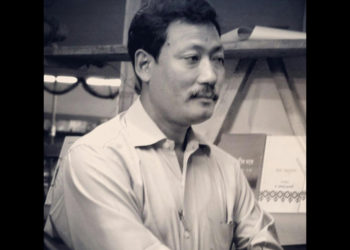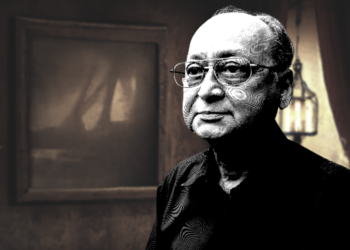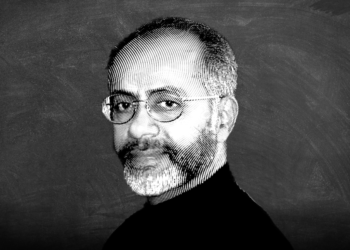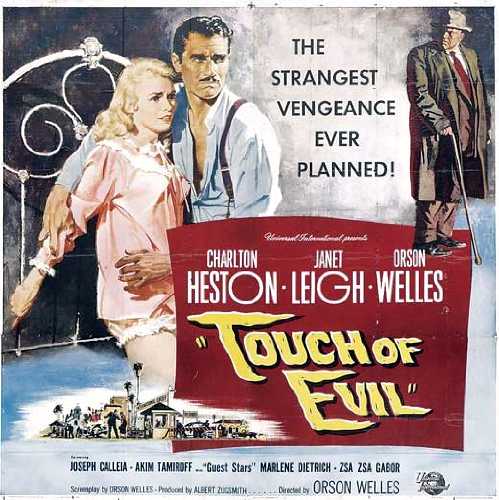
“A policeman’s job is easy only in a police state”. Inspector Ramon Migul Vargas’s now iconic line in Touch of Evil (1958), delivered with suppressed anguish, comes thundering down on us across the decades. Orson Welles, as both director and screenwriter, unsparingly depicts an American-Mexican border town: the night life, clubs, music, crime, corruption and racism. However, it’s also a time before the talk of building walls, mass deportations and children in cages. The border is as porous as walking to the next street, even though the relationships between people there are fraught, at best.
A joint investigative task force is looking into a serious crime on the American side. Orson Welles (1915-1985) plays Hank Quinlan, a surly, jaded and corrupt American detective in charge of the investigation. Charlton Heston (1923-2008), in brownface, of course, is Vargas, the Narcotics Investigator from the Mexican side. Vargas is Quinlan’s opposite in every way — upright when Quinlan is crooked; suave and handsome when Quinlan rumbles up to the investigation ungainly and ill-kempt; indignant when his counterpart frames a poor Mexican man for the crime, so that the case can be closed easily. The two characters could not have been easy for a racialised America of the 1950s to digest: the morally unsound American and the brave and righteous “Mexican”.
It’s a fair question if this set-up, complete with the “mixed-race” marriage of Vargas to Susan (Janet Leigh; later to be known for her performance in Psycho), was why the film suffered so terribly at the hands of Universal Studios. When Universal decided to adapt “Badge of Evil” by Whit Masterson for the screen, they chose Heston to play the lead. Heston, on realising that Welles had also been cast, asked the studio if they could get Welles to direct the film as well. He agreed to star in and direct the film under the condition that he was allowed to rewrite the script. The studio acquiesced, but said they’d only pay him the actor’s fee.
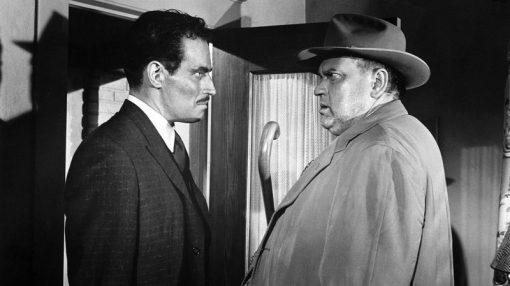
It was Welles’s decision to change the original characterisation. In an earlier script, the American detective was a moralistic Texas Ranger paired with the stereotype of the “slothful, corrupt and lecherous” Mexican1. Welles turned this on its head. It’s fascinating how Welles dealt with the film noir genre. He doesn’t try to lift it towards something lofty. The film doesn’t preach. If the film was to follow that aesthetic, it soaks up all that was considered “seedy and immoral”: the dive-bars, brothels, strip clubs, drugs and the accompanying music of those places. It’s only through the actions of the characters that the audience is forced to question where corruption and evil really lie.
In hindsight, it’s unsurprising that Universal did a hatchet job on the film during the editing phase. Unknown to Welles, they brought in Harry Keller to shoot four new scenes. When Welles saw the final cut (he was only permitted one viewing), he was anguished. Overnight he wrote a 58 page memo to the studio, comprising of suggested alterations. They paid it no mind and it was lost for decades. In the early 1990s, film preservationist and scholar Rick Schmidlin tracked down the entire memo and convinced editor Walter Murch to re-edit the film in order to restore, as closely as possible, Welles’ vision. In 1998, Touch of Evil was “re-issued” for public viewing with all the changes incorporated.
Also Read: Hindu Supremacists in America – Bharathy Singaravel
Even without the restoration, the film’s influence is said to be easily visible in Psycho (1960). Apart from the re-appearance of Janet Leigh, the motel scenes in both films are similar. Also, according to writer-filmmaker Michael Ondaatje, both Godard and Truffaut were huge fans of Touch of Evil.
Film journalists in later years have accused Universal of turning Touch of Evil into into a B movie: their heavy-handed editing and the additional scenes by Harry Keller over-explain the story and diminish Welles’s genius insight into human nature. Murch in conversation with Ondaatje, says the film is, in a way, “an investigation of the idea of borderness. What is a border? What are our expectations of the people who live there? Welles plays tricks and upsets those expectations.”

Murch’s questions and Vargas angered denouement of police cover-ups as a means to quickly close the case, echo across the bleakness that envelopes our polarised world today. In both, we can see quite plainly: the racist cruelty of Trump’s America, the deportations and caged children, police brutality towards African-Americans, extra-judicial killings in India’s Hyderabad, JMI and AMU students brutally assaulted by police and paramilitary, JNU students lathi-charged for fighting for affordable education for all, the North East on fire, plans for “detention centres” across India and the othering of migrants into “good refugees” and “bad infiltrators” through the recently passed Citizenship Amendment Act (CAA).
The restored version of Touch of Evil was screened at the India Habitat Centre, New Delhi on December 7 as part of the Habitat Film Appreciation Forum. Film critic Jai Arjun Singh, who had also chosen the film for this month’s screening, led a discussion afterwards.
1The Conversations: Walter Murch and the Art of Editing Films, Michael Ondaatje, A Borzoi Book published by Alfred A Knopf.

